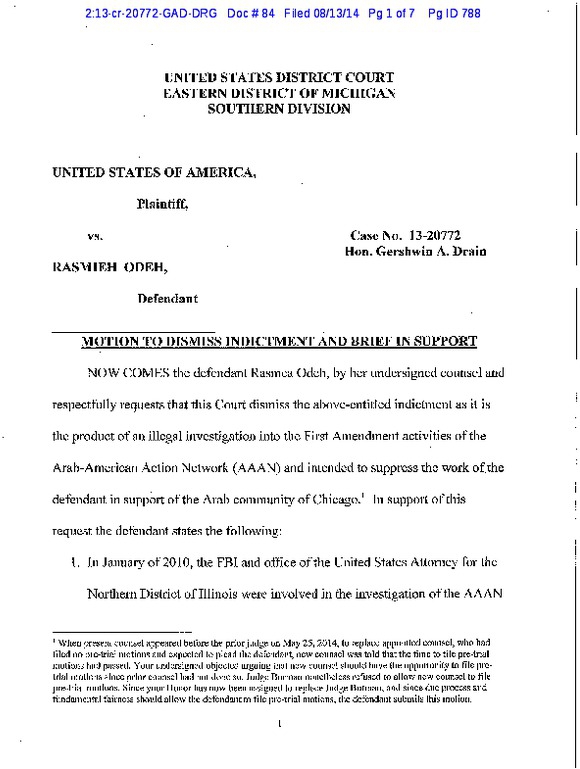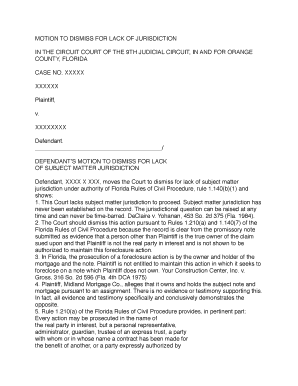
Learn more about Serving a summons and Motion to Quash. If the plaintiff does not serve the defendant in the right way, the defendant can file a Motion to Dismiss based on insufficient service of process. The plaintiff has to make sure that a copy of the summons and the complaint are given to the defendant. If the plaintiff’s complaint does not allege any damage, then the plaintiff has not alleged all elements of the claim, and the defendant may move to dismiss because the complaint fails to state a claim. The plaintiff would need to allege all elements of a negligence claim, including that the defendant had a duty to the plaintiff, which the defendant breached that duty, which the defendant’s breach of duty caused the plaintiff harm and damages. For example, in a car accident, the plaintiff may claim that the defendant was negligent.

Failure to allege all elements of the claim is a reason for a Motion to Dismiss. In the complaint, the plaintiff must also allege all of the elements of the claim. Bob can file a Motion to Dismiss the case because failing to say hello is not illegal. If the plaintiff’s complaint does not clearly say something that the defendant did that is actionable/ the court can’t give the plaintiff a judgment, so the case doesn’t need to be heard.įor example, Joe files a lawsuit claiming that Bob didn’t say hello at work. The plaintiff can’t file the case in Illinois because the court doesn’t have personal jurisdiction over the defendant. For example, a plaintiff lives in Illinois, and a defendant lives in California. If the plaintiff files the case in a state where the defendant has never lived, the court might not have authority over that person. For example, a lawsuit asking for enforcement of a child support order cannot be filed in a bankruptcy court. If the plaintiff files the case in the wrong court, then the court doesn’t have the authority to handle the lawsuit.
The defendant is a minor, or under disabilityīelow are some of the most likely reasons used by a defendant in a Motion to Dismiss. This case was already decided between the parties. Another case is pending between the same parties for the same thing. Lack of legal capacity of plaintiff or defendant. Other defects and defenses that can cause a Motion to Dismiss include: This also gives the defendant some extra time to prepare to defend against the case in other ways. This means the plaintiff can amend the complaint and bring the lawsuit a second time. Usually, if a judge grants a Motion to Dismiss because of one of these types of defects in the complaint, the case will be dismissed without prejudice. Unnecessary parties should be dismissed. The complaint contains irrelevant information that should be taken out. For example, the plaintiff did not attach a copy of the contract to the complaint The pleading does not have all of the required parts. Some reasons that a Motion to Dismiss can be filed include: Something outside of the complaint prevents the plaintiff from winning and requires the case be dismissed which is known as “affirmative defenses.”. Even if everything in the complaint is true, the plaintiff should lose the case which means the pleading is defective from the start, or. There are two different ways that a Motion to Dismiss can attack the plaintiff’s case and lead to the case being dismissed: If the defendant’s reasons are not listed in the pleadings, the defendant must attach an affidavit. When a Motion to Dismiss is filed, the defendant must include information that explains their request. When a case is dismissed without prejudice, the plaintiff is allowed to start over and file the lawsuit again. When a case is dismissed with prejudice, it means the plaintiff cannot file the same case against the same defendant again. If a Motion to Dismiss is granted on all claims, the case is ended, and the defendant wins.Ī case can be dismissed with prejudice or without prejudice. However, a motion to dismiss sometimes may be filed for some reasons at other times during the case, such as if the plaintiff amends the complaint to add a new claim. Many of the reasons for dismissing a case may only be argued at the beginning of the case before the defendant answers the complaint or files any other motion. The defendant’s answer is also considered a pleading.Ī Motion to Dismiss is often filed by the defendant right after the plaintiff serves the defendant with the complaint. 
A pleading is a formal document that starts or defends a lawsuit. The plaintiff’s case is within the complaint, which is considered a pleading.

A Motion to Dismiss asks the judge to dismiss the plaintiff’s case. A motion is a request for a judge to do something.







 0 kommentar(er)
0 kommentar(er)
